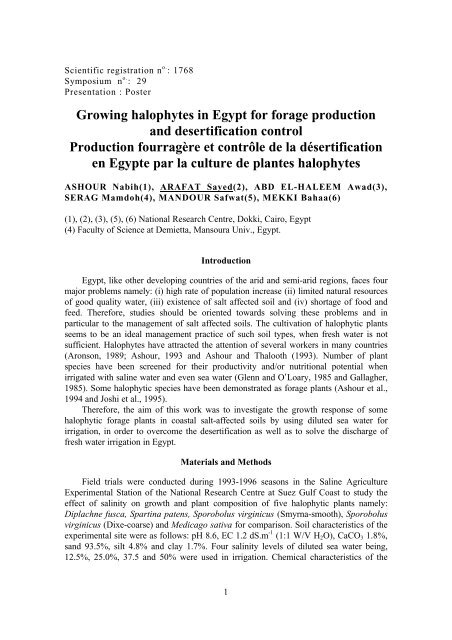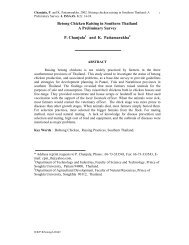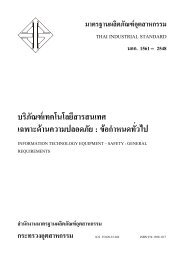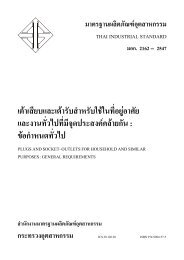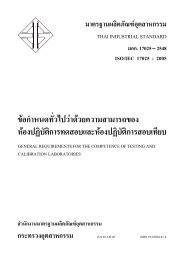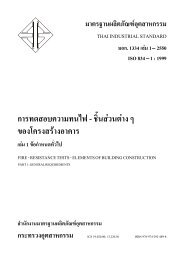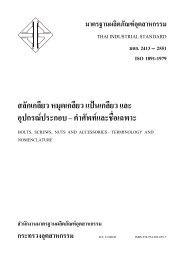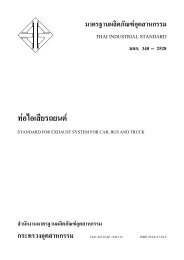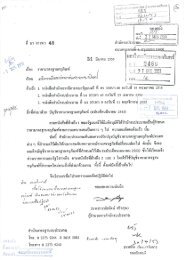Full text
Full text
Full text
You also want an ePaper? Increase the reach of your titles
YUMPU automatically turns print PDFs into web optimized ePapers that Google loves.
Scientific registration n o. : 1768<br />
Symposium n o. : 29<br />
Presentation : Poster<br />
Growing halophytes in Egypt for forage production<br />
and desertification control<br />
Production fourragère et contrôle de la désertification<br />
en Egypte par la culture de plantes halophytes<br />
ASHOUR Nabih(1), ARAFAT Sayed(2), ABD EL-HALEEM Awad(3),<br />
SERAG Mamdoh(4), MANDOUR Safwat(5), MEKKI Bahaa(6)<br />
(1), (2), (3), (5), (6) National Research Centre, Dokki, Cairo, Egypt<br />
(4) Faculty of Science at Demietta, Mansoura Univ., Egypt.<br />
Introduction<br />
Egypt, like other developing countries of the arid and semi-arid regions, faces four<br />
major problems namely: (i) high rate of population increase (ii) limited natural resources<br />
of good quality water, (iii) existence of salt affected soil and (iv) shortage of food and<br />
feed. Therefore, studies should be oriented towards solving these problems and in<br />
particular to the management of salt affected soils. The cultivation of halophytic plants<br />
seems to be an ideal management practice of such soil types, when fresh water is not<br />
sufficient. Halophytes have attracted the attention of several workers in many countries<br />
(Aronson, 1989; Ashour, 1993 and Ashour and Thalooth (1993). Number of plant<br />
species have been screened for their productivity and/or nutritional potential when<br />
irrigated with saline water and even sea water (Glenn and O’Loary, 1985 and Gallagher,<br />
1985). Some halophytic species have been demonstrated as forage plants (Ashour et al.,<br />
1994 and Joshi et al., 1995).<br />
Therefore, the aim of this work was to investigate the growth response of some<br />
halophytic forage plants in coastal salt-affected soils by using diluted sea water for<br />
irrigation, in order to overcome the desertification as well as to solve the discharge of<br />
fresh water irrigation in Egypt.<br />
Materials and Methods<br />
Field trials were conducted during 1993-1996 seasons in the Saline Agriculture<br />
Experimental Station of the National Research Centre at Suez Gulf Coast to study the<br />
effect of salinity on growth and plant composition of five halophytic plants namely:<br />
Diplachne fusca, Spartina patens, Sporobolus virginicus (Smyrna-smooth), Sporobolus<br />
virginicus (Dixe-coarse) and Medicago sativa for comparison. Soil characteristics of the<br />
experimental site were as follows: pH 8.6, EC 1.2 dS.m -1 (1:1 W/V H2O), CaCO3 1.8%,<br />
sand 93.5%, silt 4.8% and clay 1.7%. Four salinity levels of diluted sea water being,<br />
12.5%, 25.0%, 37.5 and 50% were used in irrigation. Chemical characteristics of the<br />
1
diluted sea water were determined using the methods described by the U.S. Salinity Lab.<br />
Staff (1954) and presented in Table (1).<br />
Table (1) Chemical characteristics of diluted sea water used in the Saline Agriculture<br />
Experimental Station at Suez Gulf Coast.<br />
Character Sea water proportion (%)<br />
12.5 25.0 37.5 50.0<br />
pH 8.0 8.0 8.1 8.1<br />
T.D.S. (g.L -1 ) 6.0 13.5 19.5 25.5<br />
Na (mg.L -1 ) 1910.0 3660.0 5470.0 7180.0<br />
K (mg.L -1 ) 54.6 117.0 172.0 217.0<br />
Ca (mg.L -1 ) 96.0 160.0 200.0 252.0<br />
Mg (mg.L -1 ) 216.0 420.0 593.0 806.0<br />
HCO3 (mg.L -1 ) 597.0 683.0 683.0 767.0<br />
Cl (mg.L -1 ) 3690 7460.0 10580.0 13490.0<br />
Each plant type was grown in four plots. Each plot was 4 m 2 and subjected to one<br />
of the salinity treatment.<br />
Several cuttings were taken from all tested plants during 12 months. Fresh weight of<br />
biomass was recorded. the harvested shoots were oven-dried at 65 o C, weighed, ground<br />
and analyzed for crude protein, fat and fibre, soluble carbohydrates and ash using the<br />
method of A.O.A.C. (1965).<br />
A field application was carried out to grow Diplachne fusca in salt affected soils<br />
(EC more than 17 dS.m -1 ) at the south coast of Qaroan Lack to emphasize the<br />
potentiality of this local halophyte as a forage crop under field conditions. Agricultural<br />
drainage water was used for irrigation (EC 2.8 dS.m -1 )<br />
Results and Discussion<br />
Effect of salinity on plant growth:<br />
Figure (1) shows that irrigation with diluted sea water affected the fresh and dry<br />
weights of biomass. Fresh and dry weights of the tested forage plants, except Medicago<br />
sativa increased by increasing the proportion of sea water in irrigation water from 12.5%<br />
to 25.0%. Further increase in salinity level in the irrigation water tended to decrease the<br />
fresh and dry weights of the forage halophytic plants. Yet even under 50% sea water in<br />
irrigation water the halophytic forage plants produced more than 50% of the fresh and<br />
dry weights as compared with control treatment (12.5%). The stimulatory effect of<br />
moderate salinity level on the growth of some halophytic plants was also reported by<br />
O’Leary (1988). Such growth stimulation at moderate salinity in halophytes may be<br />
attributed to improve shoot osmotic status as a result of increased ion uptake (Naidoo et<br />
al., 1995). Reduced growth at high salinities is probably associated with reduced turger<br />
and the high energy cost of massive salt secretion and osmoregualtion.<br />
Data also showed that all tested plant types tolerated diluted irrigation sea water up<br />
to 50% level. It was noticed that Sporobolus virginicus (Dixe) produced the highest<br />
biomass when the plants were irrigated with water containing either 25 or 37.5% sea<br />
water, followed by Spartina patens and Diplachne fusca. Sporobolus virginicus<br />
2
(Smyrna) gave the lowest yield. However, Leith et al. (1994), conducted field<br />
experiments in the United Arab Emirates to grow the halophytic grass Sporobolus<br />
virginicus utilizing sea water of the Arabian Gulf. The results of their experiment<br />
indicated that Sporobolus virginicus has the ability to grow in highly saline environments<br />
which exceed even those found under our experiment.<br />
Effect of salinity on plant composition :<br />
The effect of salinity on the content of crude protein, fibre, fat and ash as well as,<br />
soluble carbohydrates of all tested forage halophytic plants are illustrated in Fig. (2).<br />
Increasing salinity level in the irrigation water tended to increase crude protein content<br />
while tended to decrease crude fiber. Crude fat and soluble carbohydrates contents<br />
seemed to be unaffected by changing the salinity level in the irrigation water. In this<br />
concern Leigh (1986) reported high crude protein content of several halophytic plants.<br />
He also speculated that halophytic plants could serve as valuable protein supplement to<br />
livestock when the associated grasses were dry and possibly protein deficient.<br />
Data also showed that Medicago sativa had relatively higher content of crude<br />
protein and lower soluble carbohydrates content. Diplachne fusca and Spartina patens<br />
contained a higher amount of soluble carbohydrates. The lowest crude fat content was<br />
recorded in Spartina patens. Whereas Sporobolus virginicus (Smyrna) and (Dixe) gave<br />
the highest ash content. At all levels of salinity concentration succulence of the tested<br />
halophytic plant types were more or less similar.<br />
Field application :<br />
Table (2) summarizes the change occurred in some chemical properties of saltaffected<br />
soil as result of Diplachne fusca cultivated for two growing seasons<br />
successively. Data showed that soluble salts markedly decreased after harvesting. The<br />
percent decrease in soluble salts was 34.5% in the surface layer. The most striking<br />
change was tremendous decrease in soluble Na and Cl. This phenomenon could be<br />
explained by the ability of halophytic plant to absorb high amounts of these elements.<br />
Table (2) Some chemical properties of salt-affected soil before planting and after<br />
harvesting of Diplachne fusca.<br />
pH EC Soluble cations and anions meq 100 g -1 soil<br />
dS.m -1<br />
Na K Ca Mg HCO3 Cl<br />
Before planting 8.0 17.4 63.6 0.75 15.0 11.0 9.0 67.2<br />
After harvesting 8.0 11.2 41.2 2.1 8.8 6.0 3.2 41.7<br />
Plant composition recorded in Table (3) show that Diplachne fusca grown in salt<br />
affected soil contained considerable amounts of crude protein, fibre, fat, soluble<br />
carbohydrates as well as nutritional elements. The high sodium content (2.14%) has not<br />
presented a problem to forage species due to the presences of specific internal osmotic<br />
adjustment mechanisms.<br />
3
Table (3) Fresh, dry weight and chemical composition of Diplachne fusca grown in salt<br />
affected soil at the south coast of Qaroan Lack.<br />
Character Value Character Value<br />
Fresh weight (ton acre -1 /year) 8.2 Phosphorus % 0.16<br />
Dry weight (ton acre -1 /year) 3.2 Calcium % 0.54<br />
Crude protein % 9.2 Magnesium % 0.40<br />
Crude fibre % 31.4 Potassium % 1.02<br />
Crude fat % 1.83 Sodium % 2.14<br />
Soluble carbohydrate % 42.9 K/Na ratio 0.48<br />
Ash % 14.7<br />
Therefore, Diplachne fusca seemed to be promising forage crops as well as to overcome<br />
the desertification problems particularly in arid and semi arid regions of Egypt.<br />
References<br />
A.O.A.C. (1965). Official Methods of Analysis of Association Analytical Chemists.<br />
Washington, D.C., 20044.<br />
Aronson, J.A. (1989). Haloph: a data base of salt tolerant plants of the world. Ed., E.<br />
Whitehead, Office of Arid Lands Studies, p. 77, Univ. Arizona, Tucson, Arizona,<br />
U.S.A.<br />
Ashour, N.I. (1993). Domestication of some useful halophytes under Egyptian<br />
conditions. Proc. IV. International Conf. Desert Development, 25-30 July 1993,<br />
Mexico City, Mexico, p. 170-181.<br />
Ashour, N.I. and Thalooth, A.T. (1993). Potentiality of growing halophytes by using<br />
hyper saline water. Meeting on Desertification & Soil Reclamation in Arab Gulf<br />
Countries Region, 22-25 Nov., 1993, El-Bahrain (In Arabic).<br />
Ashour, N.I., Serag, M.S. and Abd El-Haleem, A.K. (1994). Domestication and biomass<br />
production of Kochia scoparia (L.) Roth. as a fodder-producing halophyte under<br />
Egyptian conditions. J. Fac. Sci., U.A.E. Univ., 8: No. 8, 90-102.<br />
Gallagher, J. (1985). Halophytic crops for cultivation at sea water salinity. Plant and Soil<br />
89, 323-336.<br />
Glenn, E.P. and O’Leary, J.W. (1985). Productivity and irrigation requirements of<br />
halophytes grown with sea water in the Sonar Desert Journal of Aid Environments,<br />
9, 81-91.<br />
Joshi, A.J., Mab, B.S. and Hingalajia, H. (1995). Halophytes a good source of forage<br />
production under salt stressed conditions. I. Salvadora persica. In “Biology of Salt<br />
Tolerant Plants, Ed. M. Ajmal Khan and Irwin A. Ungar, Dept. Bot., Univ. Karachi,<br />
Karachi, Pakistan, p. 353-360.<br />
Leight, J.H. (1986). Forage value and utilization of chenopod dominated shrubland.<br />
Reclamation & Revegetation Research 5, 387-404.<br />
Lieth, A.F.; Shourbagy, M.N. and Abdel-Kader, M.H. (1994). Investigation of growth,<br />
ion accumulation and chlorophyll concentration of the halophytic grass Sporobolus<br />
virginicus (L.) Kunth in highly saline environments. Regional Environmental<br />
Symposium, U.A.E. Univ., Dec. 11-14, 1994.<br />
Naidoo, J.; Jahnke, J. and Von Willert, D.J. (1995). Gas exchange responses of the C14<br />
grass Sporobolus virginicus (Poaceae) to salinity stress. In Biology of Salt Tolerant<br />
4
Plants. Ed. M. Ajmal Khan & Irwin A. Ungar, Dept. Bot., Univ. Karachi, Karachi,<br />
Pakistan, p. 121-130.<br />
O’Leary, J.W. (1988). Saline environments and halophytic crops. Proc. Intl. R and D.<br />
Conf., Arid Lands: Today and Tomorrow, Tucson, Arizona, U.S.A., Oct. 20-25<br />
(1985). Westview Press, Boulder, Colorado.<br />
U.S. Salinity Laboratory Staff (1954). Diagnosis and Improvement of Saline and Alkali<br />
Soils. U.S. Dept. of Agric. handbook No. 60.<br />
Key words : halophytes, salt-affected soil, sea water, forage production, desertification,<br />
Egypt<br />
Mots clés : halophytes, sols salés, eau de mer, production de forage, désertification,<br />
Egypte<br />
5


